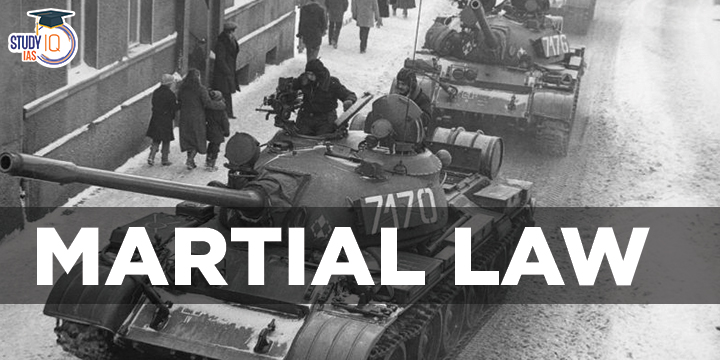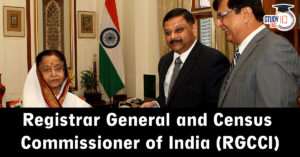Table of Contents
Martial Law is an extraordinary governance measure invoked during extreme emergencies like war, rebellion, or large-scale unrest. It transfers authority from civilian governance to military control, significantly impacting civil liberties and administrative functions. South Korea’s experience with Martial Law is deeply intertwined with its historical struggles for democracy and national security.
In this article, we explore the meaning of Martial Law, its implementation in South Korea, and its relevance in today’s geopolitical climate, especially for UPSC aspirants looking to deepen their understanding of international relations and governance systems.
Martial Law in South Korea: Historical Context
South Korea has faced multiple instances of Martial Law, particularly during its authoritarian past. Key events include:
1. The April Revolution (1960)
- Martial Law was declared to suppress student-led protests against electoral fraud during President Syngman Rhee’s administration.
- The declaration failed to curb public dissent, leading to Rhee’s resignation.
2. The Gwangju Uprising (1980)
- A significant event in South Korea’s democratization movement.
- Martial Law was declared nationwide by then-General Chun Doo-hwan to suppress protests demanding democracy.
- The military crackdown in Gwangju led to the deaths of hundreds of civilians, cementing the event as a symbol of resistance against authoritarianism.
3. Jeju Uprising (1948-1949)
- Martial Law was implemented during the Jeju Uprising, a rebellion against government forces and perceived U.S. occupation.
- The violent suppression resulted in thousands of deaths and significant human rights violations.
Current Relevance of Martial Law in South Korea
South Korea transitioned into a vibrant democracy, but the specter of Martial Law persists in discussions about national security, particularly in the following contexts:
1. Geopolitical Tensions with North Korea
- Constant threats from North Korea, including missile tests and nuclear ambitions, require South Korea to maintain readiness for emergency measures.
- Martial Law may be considered during full-scale war or severe national emergencies.
2. Domestic Unrest
- While highly unlikely in today’s democratic framework, any large-scale civil unrest could theoretically prompt discussions on Martial Law.
3. President Yoon Suk Yeol’s Administration
- Yoon Suk Yeol, South Korea’s current president, has emphasized strong military preparedness.
- Though there have been no direct threats of Martial Law under his leadership, his administration faces scrutiny over emergency powers amid regional instability.
What is Martial Law?
Martial Law Meaning
In contrast to a normal citizen government, Martial Law is a set of laws administered by the military. In a crisis or in response to an emergency, martial law may be declared to maintain control over the situation. Martial law is a short set of regulations issued by military authorities in a designated area during a crisis when the civil government is deemed unable to function. The legal repercussions of declaring martial law vary depending on the location, but they typically include the suspension of basic social equality and the extension of martial law or quasi martial equity to the general public.
Martial Law Rules
The following guidelines about Martial Law are:
| Martial Law Rules |
|
Martial Law in India
Habeas Corpus and Martial Law in India
One cannot overstate the importance of the Habeas Corpus writ. This privilege is a significant one under the Constitution and is frequently referred to as the “first security of civil liberty.” No place in India has ever declared martial law, however there have been declared emergencies. The infamous case of ADM Jabalpur v. Shivkant Shukla must never be overlooked while talking about habeas corpus and emergency (1976 SC).
AFSPA and Martial Law in India
Due to the significant impact of the Armed Forces (Special Powers) Act (1958) and the Armed Forces (Jammu and Kashmir) Special Powers Act, 1990, a detailed discussion of these laws requires a separate article and won’t be covered here. Imposing martial law is rare and serious for a civilian government. When martial law is declared, the military may take full or partial control of government functions, meaning that elected representatives no longer hold power. Civilians give up their control in hopes of restoring order, but there’s a risk that this control may never return.
During martial law, civil liberties—like the freedom to move, express opinions, and protection from arbitrary searches—can be restricted. Military tribunals replace regular courts to handle legal cases.
Under martial law, even minor offenses, like curfew violations, can lead to arrests. Additionally, laws protecting against wrongful imprisonment, like habeas corpus, can be suspended, allowing the military to detain people without a chance for release indefinitely.
Case Law
In A.D.M Jabalpur v. S. Shukla (1976), the Supreme Court noted that martial law is a limited measure and involves military authorities taking control, which is outside the scope of Article 359(1) of the Constitution.
Martial Law vs. National Emergency
| Martial law | National Emergency |
| It affects only Fundamental Rights | It affects Fundamental Rights, centre-state relations etc |
| It suspends the government and ordinary law courts | Continues their existence |
| Imposed to restore law and order. | War, external aggression or armed rebellion |
| Imposed in some specific areas of the country | Some or whole of the country |
| No specific provision in the constitution | Specific and detailed provision |
Martial Law Declaration
Declaring Martial Law is a last resort saved for circumstances where peace and order are fast deteriorating because to the detrimental effects it can have on a nation and its population. For instance, the governor of Idaho imposed martial law in 1892 after a group of unruly mine workers detonated a mill, razing a four-story structure and leaving numerous people dead.
To put an end to demonstrations, civil unrest, or insurrections, martial law may be proclaimed. Additionally, it may be announced after a war when a nation’s military occupies a foreign country.
Typically, a country’s president or other top civilian leader has the authority to impose martial law. Legislation or a nation’s constitution controls the conditions under which it may be declared as well as other restrictions, such how long it may last.
For instance, a president may be permitted to impose martial law for a maximum of 60 days when there is severe civil unrest. If a nation has ratified a multilateral treaty, international rules may also be used to restrict the application and duration of martial law.
Emergency Martial Law: What Does It Entail?
Emergency Martial Law refers to a state where military control is enforced swiftly to address national emergencies like:
- Invasion by a foreign power.
- Armed rebellion or large-scale terrorism.
- Catastrophic events disrupting national stability.
Under Emergency Martial Law:
- Military tribunals replace civilian courts.
- Civilian government functions are temporarily suspended.
- Curfews, censorship, and movement restrictions may be imposed.
Economic Impacts: KOSPI Index and Market Stability
South Korea’s KOSPI Index, a key indicator of its stock market, reacts sharply to political and military developments.
- Martial Law declarations can lead to market instability due to investor concerns about governance and security.
- Historical instances like the Gwangju Uprising caused significant economic disruptions.
Today, South Korea’s government prioritizes stability to avoid such outcomes.
Conclusion
Martial Law in South Korea remains a potent reminder of the delicate balance between security and democracy. While historical instances highlight its potential for misuse, the country’s transition to a democratic framework ensures that such measures are only theoretical in the modern era.
For UPSC aspirants, understanding Martial Law in the context of South Korea offers valuable insights into governance during crises, the role of the military, and the resilience of democratic systems amidst geopolitical challenges


 Mechanisms to Combat Judicial Corruption...
Mechanisms to Combat Judicial Corruption...
 Registrar General and Census Commissione...
Registrar General and Census Commissione...
 Ambedkar Jayanti 2025: Biography, Legacy...
Ambedkar Jayanti 2025: Biography, Legacy...





















